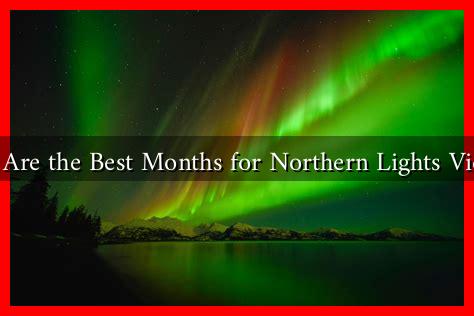-
Table of Contents
What Are the Best Months for Northern Lights Viewing?
The Northern Lights, or Aurora Borealis, are one of nature’s most breathtaking phenomena, captivating millions of travelers and photographers each year. However, witnessing this spectacular light show requires careful planning, particularly regarding timing. In this article, we will explore the best months for Northern Lights viewing, the factors that influence visibility, and tips for maximizing your chances of experiencing this magical display.
Understanding the Northern Lights
The Northern Lights occur when charged particles from the sun collide with gases in the Earth’s atmosphere, creating vibrant displays of color in the night sky. These lights are most commonly seen in high-latitude regions near the Arctic Circle, including countries like Norway, Sweden, Finland, Canada, and Alaska.
Optimal Months for Viewing
While the Northern Lights can technically be seen year-round, certain months offer significantly better chances for viewing. The best months for Northern Lights viewing are:
- September to March: This period is generally considered the prime time for Northern Lights sightings.
. The long, dark nights and clearer skies during these months create ideal conditions.
- December to February: These months are particularly popular due to the extended hours of darkness. In places like Tromsø, Norway, the sun does not rise for several weeks, providing ample opportunity for viewing.
- March: As winter transitions to spring, March often offers a combination of clear skies and increased solar activity, making it a fantastic month for sightings.
Factors Influencing Visibility
Several factors can affect your chances of seeing the Northern Lights, including:
- Solar Activity: The intensity of the Northern Lights is closely linked to solar activity, which follows an 11-year cycle. Higher solar activity increases the likelihood of vibrant displays.
- Weather Conditions: Clear skies are essential for visibility. Cloud cover can obstruct the view, so checking local weather forecasts is crucial.
- Location: Being in a dark area away from city lights enhances visibility. Popular viewing spots include national parks and remote villages.
Case Studies: Popular Viewing Locations
Different locations around the world offer unique experiences for Northern Lights viewing. Here are a few notable examples:
- Tromsø, Norway: Known as the “Gateway to the Arctic,” Tromsø is one of the best places to see the Northern Lights. The city offers various tours and activities, making it a popular destination for tourists.
- Fairbanks, Alaska: Fairbanks is situated directly under the Auroral Oval, making it an excellent location for viewing. The city hosts the annual “Aurora Winter Train” that takes visitors to prime viewing spots.
- Yellowknife, Canada: Located in the Northwest Territories, Yellowknife is renowned for its clear skies and frequent auroral activity. The city has a dedicated “Aurora Village” where visitors can enjoy the lights in comfort.
Tips for Maximizing Your Viewing Experience
To enhance your chances of witnessing the Northern Lights, consider the following tips:
- Plan Ahead: Research solar activity forecasts and choose your travel dates accordingly. Websites like [NOAA’s Space Weather Prediction Center](https://www.swpc.noaa.gov/) provide valuable information.
- Stay Flexible: Be prepared to change your location based on weather conditions. Sometimes, a short drive can lead to clearer skies.
- Dress Warmly: Northern Lights viewing often involves long periods outdoors in cold temperatures. Layering and proper winter gear are essential.
Conclusion
In summary, the best months for Northern Lights viewing are from September to March, with December to February being particularly favorable due to extended darkness. Factors such as solar activity, weather conditions, and location play crucial roles in visibility. By choosing the right time and location, and following practical tips, you can significantly increase your chances of experiencing this awe-inspiring natural phenomenon. Whether you find yourself in Norway, Alaska, or Canada, the Northern Lights promise an unforgettable adventure that will leave you in awe of nature’s beauty.





